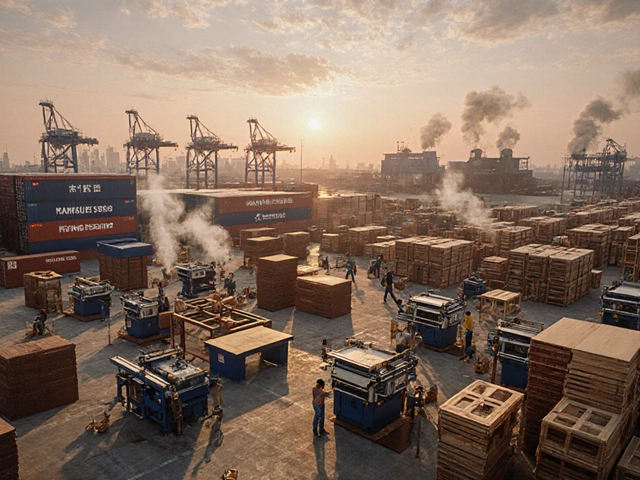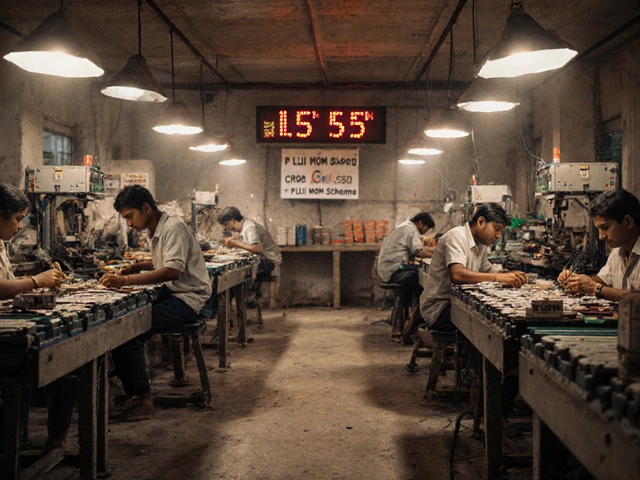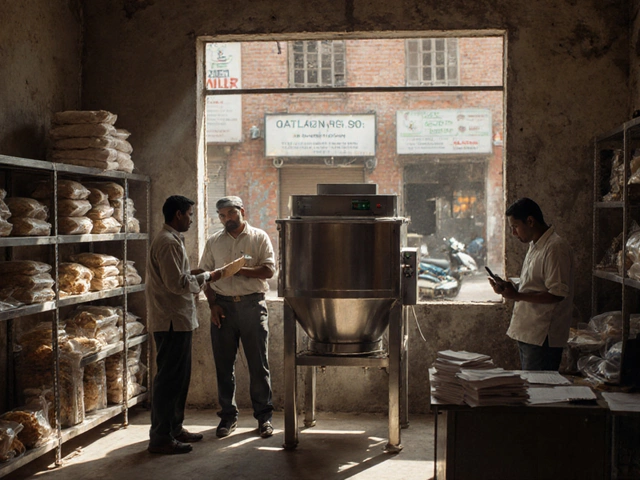Ever wondered why one factory is called a small scale industry while another isn’t, even if they look pretty similar from the outside? There’s more to it than meets the eye. It all comes down to a few key benchmarks—think investment limits, number of workers, and types of products. In India, for example, anything with plant and machinery investments up to Rs. 10 crore (and under 50 crore for services) falls under this tag. These numbers aren’t random—they give small businesses a fair shot at government schemes and easier access to loans.
This makes knowing exactly which industries count as ‘small scale’ really important if you’re thinking about diving into manufacturing or even service-related businesses. Food processing, textiles, leather goods, chemicals, even things like sports equipment—they’re all on the cards. Surprised? Plenty of folks think small scale means something old-fashioned or low-tech, but you’ll also find high-quality electronics and precision parts right in this category. The diversity here is wild, and knowing where your business fits can make all the difference when you go looking for support or financial help.
- Defining Small Scale Industries: The Real Benchmarks
- Major Sectors Considered Small Scale
- Standout Examples and Surprising Inclusions
- Tips for Getting Started in Small Scale Manufacturing
Defining Small Scale Industries: The Real Benchmarks
If you’re thinking about starting a small scale industry, it’s good to know the rules that actually matter. You can’t just call any business small because it feels small. There are concrete numbers behind these definitions, especially if you’re trying to unlock MSME benefits or government support.
In India, the rules for what qualifies as a small scale industry have changed a bit over the years. The key stuff comes down to two main things: the investment in plant and machinery for manufacturing or investment in equipment for services, and sometimes, revenue turnover. Let’s get specific:
- For manufacturing units: If you’ve invested up to Rs. 10 crore (about $1.2 million) in plant and machinery, your business is classed as small scale.
- For services: The upper limit is Rs. 5 crore (around $600,000) in equipment.
The government recently tweaked these caps to make it easier for startups and existing small businesses to grow without slipping out of this protected bracket. There’s also an annual turnover rule—if your business makes up to Rs. 50 crore (roughly $6 million) per year, you’re still considered in the small scale manufacturing club.
| Sector | Investment Limit | Annual Turnover Limit |
|---|---|---|
| Manufacturing | Up to Rs. 10 crore | Up to Rs. 50 crore |
| Services | Up to Rs. 5 crore | Up to Rs. 50 crore |
Another thing that matters—a business has to be registered under the MSME Act to actually be recognized as a small scale industry. Without this, you’re on your own if you want government support, cheaper loans, or subsidies. Registration today is mostly digital (Udyam Registration), making the paperwork less of a headache.
So, if you’re planning to step into small scale industries, keep a close eye on these numbers. The minute you cross these limits, you lose the extra advantages that small businesses get in India. These lines may sound strict, but they’re there to level the playing field and keep out the big fish.
Major Sectors Considered Small Scale
When you think of small scale industries, a bunch of different businesses should spring to mind. We’re not just talking about cottage industries or tiny workshops—there are some surprisingly big players counted in this zone, at least by the official standards. Let’s walk through the main sectors that make the list.
- Food Processing: From local bakeries to small packaging plants, this sector is stacked with small scale outfits. They often focus on niche snacks, dairy products, spices, or pickles. Quick fact: More than 70% of all food processing units in India are considered small scale.
- Textiles & Garments: This is a classic. Clothes makers, handloom producers, and embroidery shops are everywhere. Most brands you see at street markets often trace back to small textile manufacturing operations.
- Plastic Products: Everyday things like plastic containers, buckets, and packaging are pumped out by these businesses. They run with a tight crew but churn out tons of products.
- Engineering Components: You might not see it, but stuff like auto parts, screws, nuts, and bolts usually comes from the small scale sector. Auto ancillaries, especially, are packed with MSMEs.
- Chemicals & Cosmetics: Small units often whip up soaps, detergents, cleaning agents, and even beauty products. They’re a huge force in the domestic market.
- Leather and Leather Goods: Think wallets, belts, shoes, and bags. Places like Kanpur and Agra are buzzing with these small-scale units.
- Sports Equipment: Did you know that most of the cricket bats, balls, and gloves used at schools and clubs come from small businesses? The town of Jalandhar runs almost entirely on this industry.
- Electronics Assembly: Small electronics—like LED lights, adapters, or phone chargers—are often pieced together in compact units, not mega-factories.
The sector breakdown isn’t just for show. Here’s a quick look at how MSMEs (Micro, Small & Medium Enterprises) stack up in India by share, just to drive home how crucial these sectors are:
| Sector | Typical Products | % of Total MSMEs |
|---|---|---|
| Manufacturing | Textiles, Food, Plastics | 31% |
| Trade | Retail, Wholesale | 36% |
| Services | Repairs, IT, Hospitality | 33% |
Most people only notice the final product, but small scale manufacturing touches almost everything you use in daily life. If you’re wondering where you could fit in, it helps to pick a sector you actually use or understand—odds are, there’s already a thriving community doing the same, just on a smaller but efficient scale.

Standout Examples and Surprising Inclusions
If you only picture handmade soap or tiny local bakeries when someone mentions small scale industries, you're honestly just scratching the surface. This label covers way more ground than most people realize. Sure, food processing is classic—everything from spice packaging to small chocolate brands. But did you know sports equipment makers from Meerut, or even companies rolling out low-volume electronics, also count as small scale industries?
One eye-opener: India's massive textile scene is powered by thousands of these businesses. In fact, the textile and garment sector accounts for nearly 45% of the total output of the country’s small scale segment. That’s a huge chunk, and we’re not talking just traditional wear—jeans, T-shirts, specialty fabrics, you name it.
You’ll also find medicine and pharmaceutical companies on the list, but not the giant brands—rather, those making generic drugs or wellness capsules in smaller batches. Leather goods, from belts to women’s purses, often start as small workshops that fit right into this category.
Here’s something many folks miss: auto parts. Car and bike manufacturers rely on tons of small units making fasteners, rubber hoses, or little plastic clips. These units might only run with 15 workers and a couple of machines, but they fuel massive industries.
- Textiles and garments: From sarees in Surat to export-ready T-shirts.
- Food and agro-processing: Ready-to-eat snacks, pickles, flour mills.
- Leather goods: Shoes, wallets, belts—all typically small batch.
- Electronics: Circuit boards, computer cables, basic assembly lines.
- Plastic and rubber products: Toys, auto parts, household goods.
- Chemicals: Paints, cleaning products, incense sticks.
Want a quick look at how small scale industries show up across sectors? Here’s a sample breakdown:
| Industry Type | Key Products | Typical Workforce |
|---|---|---|
| Textiles | Sarees, T-shirts, Handlooms | 10-50 |
| Food Processing | Snacks, Pickles, Spices | 5-25 |
| Engineering Parts | Auto Bolts, Fasteners | 10-30 |
| Electronics | PCBs, Assembly | 5-20 |
| Leather Goods | Bags, Belts, Shoes | 8-25 |
The tag of small scale industry isn’t just for old-school enterprises—some highly specialized, tech-driven companies fit the bill thanks to their smaller size and focused markets. So if you’re developing drone parts or IoT gadgets in a compact unit, you could be eligible for the benefits that come with this category.
Tips for Getting Started in Small Scale Manufacturing
If you’re eyeing the world of small scale industries, it pays to keep things simple and focused in the beginning. Picking the right product matters most. There’s real demand for items like textiles, food products, shoes, or even low-cost electronics in the local market. But don’t just follow trends—start with what you know or what you can easily learn. A lot of successful manufacturers kicked off with something familiar before scaling up.
You can’t escape the paperwork. Get your business registered early—apply for an MSME (Micro, Small and Medium Enterprises) certificate online. This opens up government schemes, easier loans, and protection from delayed payments. Many new founders miss this step and lose out on subsidies and access to cheaper credit.
Funding can get tricky. Some use personal savings or small loans from family, but there are heaps of other options. Banks like State Bank of India, Punjab National Bank, and HDFC run special schemes for small scale manufacturing. NABARD and SIDBI have good loan deals too. Always compare interest rates and ask about hidden fees before saying yes to anything.
Picking the right location can give you a big boost. Industrial estates and clusters often offer cheap land or ready-to-move sheds along with supply chain support. You’ll also find it easier to get labor and raw materials close by.
Here’s a quick checklist to keep you on track:
- Do basic market research—don’t skip this step.
- Calculate startup costs (machinery, space, licenses, raw materials).
- Register your business as an MSME.
- Open a business bank account—don’t mix it with your personal cash.
- Apply for the right licenses (FSSAI for food, BIS for some electronics, etc.).
- Hire a handful of reliable people—you don’t need a big team at first.
- Start small, but keep records of everything—helps if you want a loan later.
One cool stat: Nearly 97% of manufacturing units in India fall under the small scale industries category. They punch way above their weight, making up about 45% of total manufacturing output. Your small setup isn’t just a tiny blip—it’s a real part of what keeps the economy moving.





